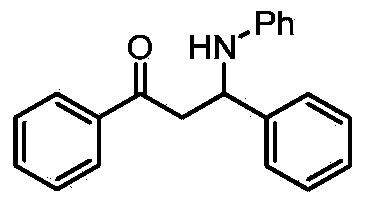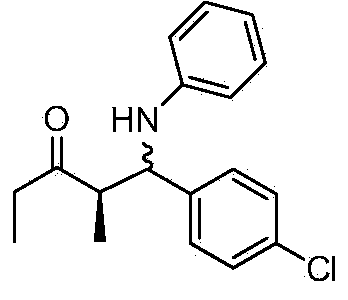Method for preparing beta-amino-carbonyl compound
A technology for aminocarbonyl compounds, applied in the field of preparation of β-aminocarbonyl compounds, can solve the problems of complex substrates, harsh reaction conditions, and long reaction time in the operation process, and achieve high atom economy, simple operation, and great application potential Effect
- Summary
- Abstract
- Description
- Claims
- Application Information
AI Technical Summary
Problems solved by technology
Method used
Image
Examples
Embodiment 1
[0013] Taking the preparation of the following formula compound 1,3-diphenyl-3-(phenylamino)-1-acetone as an example, the raw materials used and the preparation method thereof are as follows:
[0014]
[0015] Put 203uL (2.0mmol) benzaldehyde, 201uL (2.2mmol) aniline, 467uL (4.0mmol) acetophenone, 24.9mg (0.1mmol) titanocene dichloride, 13.8mg (0.1mmol) salicylic acid in the reaction bottle , reacted at room temperature for 1 hour, stopped the reaction, added 2 mL of saturated aqueous sodium bicarbonate solution to the system, extracted three times with 10 mL of ethyl acetate, combined the organic phases, dried with anhydrous sodium sulfate, and separated by column chromatography to obtain a white solid product. Its yield is 97%. The resulting product was characterized by a Bruker Avance superconducting Fourier digital NMR spectrometer, and the characterization data are as follows: 1 H NMR (400MHz, CDCl 3 )δppm: 7.89(m, 2H), 7.55(m, 1H), 7.43(m, 4H), 7.32(dd, J=10.3, 4.7H...
Embodiment 2
[0017] Taking the preparation of the following formula compound 1-phenyl-3-(2-chlorophenyl)-3-(4-methoxyphenylamino)-1-acetone as an example, the raw materials used and the preparation method thereof are as follows:
[0018]
[0019] In Example 1, the benzaldehyde used was replaced with equimolar o-chlorobenzaldehyde, and aniline was replaced with equimolar p-methoxyaniline. The other steps were the same as in Example 1 to prepare a white solid 1-phenyl-3 -(2-chlorophenyl)-3-(4-methoxyanilino)-1-propanone, its productive rate is 79%, and the characterization data are: 1 H NMR (400MHz, CDCl 3 )δppm: 7.95 (d, 2H), 7.68-7.72 (m, 1H), 7.53-7.60 (m, 2H), 7.40-7.47 (m, 2H), 7.22-7.30 (m, 1H), 7.07-7.14 ( m, 1H), 6.58-6.72(m, 4H), 5.28-5.34(m, 1H), 3.74-3.85(m, 1H), 3.69(s, 3H), 3.42-3.54(m, 1H); 13 C NMR (101MHz, CDCl 3 )δppm: 198.32, 152.46, 141.33, 140.56, 136.63, 133.31, 133.02, 128.69, 128.48, 128.44, 128.24, 127.90, 122.62, 114.96, 114.68, 55.51, 54.829, 43.9
Embodiment 3
[0021] Taking the preparation of the following formula compound 2-methyl-1-(4-chlorophenyl)-1-anilino-3-pentanone as an example, the raw materials used and the preparation method thereof are as follows:
[0022]
[0023]In Example 1, the benzaldehyde used is replaced with equimolar p-chlorobenzaldehyde, and acetophenone is replaced with equimolar 3-pentanone. Other steps are the same as in Example 1, and a light yellow solid 2-methyl -1-(4-chlorophenyl)-1-anilino-3-pentanone, the yield is 81%, the cis-trans ratio is 74:26, and the characterization data are: 1 H NMR (400MHz, CDCl 3 )δppm: 7.17(t, J=8.2Hz, 4H), 6.99(t, J=7.5Hz, 2H), 6.57(d, J=7.1Hz, 1H), 6.38(d, J=7.5Hz, 2H) , 4.56(d, J=5.3Hz, 1H), 2.89(m, 1H), 2.27(m, 2H), 1.10(d, J=6.9Hz, 1H), 1.02(d, J=6.9Hz, 3H) , 0.87(t, J=7.1Hz, 3H); 13 C NMR (101MHz, CDCl 3 )δppm:213.88,211.97,145.69,139.36,138.85,131.99,131.93,128.13,128.09,127.82,127.76,127.27,126.96,116.92,116.51,112.66,112.29,76.33,76.02,75.70,59.02,57.63,50.98...
PUM
 Login to View More
Login to View More Abstract
Description
Claims
Application Information
 Login to View More
Login to View More - R&D
- Intellectual Property
- Life Sciences
- Materials
- Tech Scout
- Unparalleled Data Quality
- Higher Quality Content
- 60% Fewer Hallucinations
Browse by: Latest US Patents, China's latest patents, Technical Efficacy Thesaurus, Application Domain, Technology Topic, Popular Technical Reports.
© 2025 PatSnap. All rights reserved.Legal|Privacy policy|Modern Slavery Act Transparency Statement|Sitemap|About US| Contact US: help@patsnap.com



